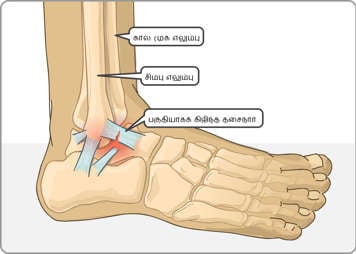கணுக்கால் சுளுக்கு என்பது என்ன?
கணுக்கால்ப் பகுதியில் உள்ள எலும்புகளில் ஒட்டியிருக்கும் தசைநார்கள் இழுபடுவதே கணுக்கால் சுளுக்காகும். தசைநார்கள் உங்கள் எலும்புகளுடன் ஒட்டி மூட்டுகளை அதன் இடத்தில் பிடித்திருக்கும், நீளும் தன்மையுள்ள பட்டிகளாகும். கணுக்கால் சுளுக்கு பிள்ளைகளுக்கு ஏற்படும் ஒரு பொதுவான காயமாகும்.

உங்கள் பிள்ளை போட்டி விளையாட்டின்போது தன் காலை முறுக்கி வைத்திருக்கக்கூடும் அல்லது இந்தக் காயம் ஏற்படும்வண்ணம் தன் காலை ஒரு வித்தியாசமான முறையில் கீழே வைத்திருக்ககூடும். பிள்ளைகளில் கணுக்கால் சுழுக்கு சாதாரணமானது.
கணுக்காற் சுளுக்கு பெரும்பாலும் கணுக்காலின் வெளிப்பகுதியிலேயே சம்விக்கும். அதாவது கணுக்கால் உட்பக்கமாக முறுக்கப்பட்டிருக்கும். கணுக்கால் வெளிப்பக்கமாகவும் முறுக்குப் படலாம்.
வீரியம் குறைந்த காயம் என்பது, சிறிதளவு வீக்கத்துடன் தசை நார்கள் சுளுக்கப்பட்டுக் காணப்படுவது. கடுமையான காயம் என்பது அதிகளவு வீக்கத்துடன் தசைநார்கள் கிழிந்து காணப்படுவதாகும்.
கணுக்கால் சுளுக்கின் அடையாளங்களும் அறிகுறிகளும்
கீழ்க்காண்பனபற்றி உங்கள் பிள்ளை குறை சொல்லக்கூடும்:
- நடப்பதில் சிரமம்
- கடுமையற்ற அளவிலிருந்து கடுமையானது வரையான வலி
- கணுக்காலில் மட்டுப்படுத்தப்பட்ட அசைவு
வேறு அடையாளங்கள் கீழ்க்காண்பனவற்றை உட்படுத்தக்கூடும்:
- கணுக்காலின் முற்பகுதியிலும் பக்கவாட்டிலும் வீக்கமும் சிராய்ப்புப் புண்ணும்
- எலும்புகளின் சுற்றுப்பகுதிகளில் வலியுணர்வு ஆனால் எலும்புப் பிதுக்கம் உள்ள பகுதிகளில் சிறிது வலி அல்லது வலியின்மை.
கணுக்கால் சுளுக்கை சமாளித்தல்
கணுக்கால் உறுதியாகவும் எலும்பில் வலியுணர்வோ அல்லது புண் உணர்வோ இல்லாவிடில் சோதனைகள் தேவைப்படாது. மூட்டு உறுதியாக இல்லாவிடில் அல்லது எலும்பில் குறிப்பிடத்தக்க வலியுணர்வோ புண் உணர்வோ இருந்தால் X-ரே அல்லது அல்ட்ரா சவுண்ட் சோதனை செய்யப்படலாம்.
உங்கள் பிள்ளையை வீட்டில் பராமரித்தல்
ஓய்வு, ஐஸ், அழுத்தமேற்றல், உயர்த்துதல்
முதல் 24 மணி நேரங்களுக்கு கணுக்காலுக்கு ஓய்வு கொடுக்கவும்.
உங்கள் பிள்ளை விழித்திருக்கும்போது 3 நாட்களுக்கு ஒவ்வொரு 4 மணி நேரத்துக்கு ஒரு தடவை 30 நிமிடங்களுக்கு வீங்கிய அல்லது வலியுள்ள பகுதியில் ஐஸ் பக்கற் வைக்கவும்.
வீக்கத்தைக் குறைக்க உதவும் பொருட்டு மெத்தை ஒன்றைப் பயன்படுத்தி கணுக்காலை இருதயம் இருக்கும் மட்டத்தைவிட உயர்வாக்கவும்.
ஐபியூபுரோஃபென், தாங்கிப்பிடிக்கும் பன்டேஜுகள், மற்றும் ஊன்று கோல்கள்
வலியை சமாளிக்கவும் வீக்கத்தைக் குறைக்கவும் உங்கள் பிள்ளைக்கு ஐபியூபுரோஃபென் ( அட்வில், மோட்ரின், அல்லது வேறு பிரான்டுகள்) கொடுக்கும்படி உங்கள் வைத்தியர் அலோசனை வழங்கக்கூடும்.
தாங்கிப்பிடிக்கும் பன்டேஜுகள் அல்லது ஒரு எயார்காஸ்ட் (aircast) உபயோகிப்பது வீக்கத்தை அழுத்துவதோடு கணுக்கால் மேலும் காயமடைவதைத் தடுக்கும்.
நடப்பத்தில் சிரமம் இருந்தால் உங்கள் பிள்ளை ஊன்றுகோல்களை உபயோகிக்கலாம்.
வலிமையேற்றும் பயிற்சிகள்
உங்கள் பிள்ளையின் சுளுக்கைப் பொறுத்து, காயமேற்பட்ட 48 மணி நேரங்களுக்குள்ளாகவே அவள் கணுக்கால்ப் பயிற்சிகளை ஆரம்பிக்கலாம். இந்த பயிற்சிகள் கணுக்காலை பின் பக்கமாக, முன்பக்கமாக, உட்பக்கமாக, வெளிப்பக்கமாக அதன் முழு இயல்பான வீச்சினூடாக அசைப்பதை உட்படுத்தும். சமநிலையை மேம்படுத்த காயம்பட்ட காலில் நிற்பது அவசியம். அரம்பத்திலேயே இலகுவான பாரம்-தாங்குவதும் நடப்பதும் குணமடைவதற்கு உதவி செய்யும்.
காயம் ஆற 2 வாரங்களுக்கு மேலாகலாம், பூரண குணமடைதல் 10 தொடங்கி 12 வரையிலான வாரங்கள் எடுக்கலாம்.
மருத்துவ உதவியை எப்போது நாடவேண்டும்
48 மணி நேரங்களுக்குப் பிறகு நடப்பதில் மிகுந்த சிரமமும் தொடருகின்ற வலியும் இருந்தால் உங்கள் வைத்தியர் கணுக்காலை மீண்டும் பரிசோதனை செய்ய வேண்டும். மேலதிகமான பயிற்சியும் உடலியக்க மருத்துவமும் (பிசியோ தெரப்பி) தேவைப்படலாம்.
மீண்டும் விளையாட்டுகளில் ஈடுபடுதல்
கணுக்காலில் முழுமையான அசைவும் முழுமையான வலிமையும் வந்த பின்பு உங்கள் பிள்ளை மீண்டும் விளையாட்டுகளில் ஈடுபடலாம். உங்கள் பிள்ளையை காயம்பட்ட காலில் 5 தடவை துள்ள வைப்பதன் மூலம் கணுக்கால் வலிமையை நீங்கள் சோதிக்கலாம். உங்கள் பிள்ளை வலி அல்லது உறுதியின்மைக்கான அடையாளங்களைக் காட்டுகின்றதா என்பதைக் கவனியுங்கள். வளைந்து நெளிந்து செல்லும் விதத்தில் உங்கள் பிள்ளையால் சுலபமாக ஓட முடிகின்றதா எனப் பார்ப்பது இன்னொரு சோதனையாகும்.
அதி விரைவாக மீண்டும் விளையாட்டுகளில் ஈடுபடுவது கணுக்கால் மேலும் காயமடைவதற்கான ஆபத்தை அதிகரிக்கும். முற்று முழுமையான குணமடைதல் இல்லாமல், உங்கள் பிள்ளை வளர்ந்த பின்பு நீண்டகால பிரச்சனைகளை எதிர்நோக்கலாம். உடலை சூடேற்றும் பயிற்சிகள் மற்றும் வார் உள்ள தாங்கிப்பிடிக்கும் பொருட்களின்(lace-up support) உதவி என்பன கணுக்கால் மேலும் காயமடைவதைத் தடுக்கும். உயர்ந்த அளவு போட்டியுள்ள விளையாட்டுகளில் மீண்டும் ஈடுபடும் நோக்கமானது, விளையாட்டுடன் தொடர்புள்ள காயங்கள்பற்றிய அறிவுள்ள சுகநலப் பராமரிப்பாளர் ஒருவரினால் வழிநடத்தப்படலாம்.
முக்கிய குறிப்புகள்
- கணுக்கால்க் காயங்கள் வலியையும் வீக்கத்தையும் உண்டுபண்ணும்.
- குணமடைதல் நேரத்தையும் பொறுமையையும் தேவைப்படுத்துகிறது.
- கணுக்கால் குணமடைவதை உடற் பயிற்சி அதிகரிக்கும்.
- தீவிரமான காயங்களானது, எலும்பு மற்றும் மூட்டுக் காயங்கள் மற்றும் பிரச்சனைகள் தொடர்பான அறிவுடைய நிபுணரால் மதிப்பீடு செய்யப்பட வேண்டும்.
- அதி விரைவாக மீண்டும் விளையாட்டுகளில் ஈடுபடுவது கணுக்காலில் நீண்டகால சிக்கலைத் தோற்றுவிக்கும்.
